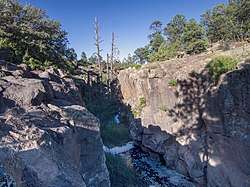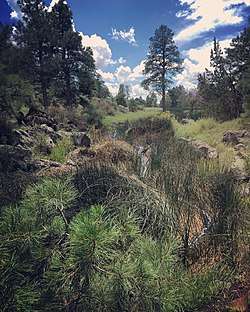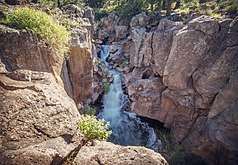Picture Canyon Natural and Cultural Preserve
The Picture Canyon Natural and Cultural Preserve is an archaeological site and a nature preserve open to the public year-round, located in northeast Flagstaff, Arizona.[2] The preserve is used for educating the community about ecology, geology and archaeology along with general outdoor recreation.
Picture Canyon Archeological Site | |
 | |
 | |
| Location | El Paso Flagstaff Road, Flagstaff, Arizona |
|---|---|
| Coordinates | 35.22903°N 111.55347°W |
| Area | 30 acres (12 ha) |
| NRHP reference No. | 07001349[1] |
| Added to NRHP | January 10, 2008 |
History
Picture Canyon was listed on the National Registry of Historic Places on January 10, 2008. The 478-acre preserve was purchased October 30, 2012 at a public auction on the steps of Coconino County Courthouse from the State Land Department by the City of Flagstaff for $4.8 million after several community groups rehabilitated the area and rallied decades for its protection. An agreement was made with the Wildcat Hill Wastewater Treatment Plant, located immediately south of the preserve, to provide a constant water source for the riparian habitat and wildlife. Reclaimed water is discharged into a pond which feeds the Rio de Flag through a rugged geological canyon composed of basalt rock. Thousands of years ago, between 700-1300 AD, this area was home to the natives known as the Northern Sinagua (people without water). Picture Canyon is named for the large density of petroglyphs created by the Sinagua located along the river. Hundreds of panels were created depicting archers, geometric shapes, and local animals like birds and turtles.
Trails and Natural Features
There are three trails within the preserve:
- Tom Moody Trail is a 2.8-mile outer loop within the preserve. An outdoor classroom with educational panels is located near the start of the trail. The southeast section of the trail initially runs parallel with the Rio De Flag and along the canyon walls where a visitor can view the waterfall within the preserve. Continuing northeast, after crossing the Rio De Flag Bridge, will bring a visitor to a waterbird petroglyph site.
- Don Weaver Trail is a 0.7-mile section connecting with the Tom Moody Trail to create a smaller loop and brings a visitor to the opposite side of the canyon walls for another view of the waterfall.
- Arizona Trail is a 1.5-mile section of the larger 800+ mile trail that spans from Mexico to Utah, and bisects the Tom Moody Trail.
Gallery
- Picture Canyon, National Register of Historic Places
 Tom Moody Trail
Tom Moody Trail Don Weaver Trail
Don Weaver Trail Waterfall - view from Tom Moody Trail
Waterfall - view from Tom Moody Trail Meadow at the Rio De Flag bridge.
Meadow at the Rio De Flag bridge.
References
- "National Register Information System". National Register of Historic Places. National Park Service. November 2, 2013.
- "Picture Canyon Natural and Cultural Preserve | City of Flagstaff Official Website". www.flagstaff.az.gov. Retrieved 2018-09-03.
External links
| Wikimedia Commons has media related to Picture Canyon Natural and Cultural Preserve. |